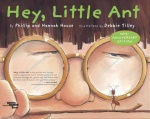Closer to the Ground, Fostering Compassion
June 11, 2022
Quote of the Week
"As a child, one has that magical capacity to move among the many eras of the earth; to see the land as an animal does; to experience the sky from the perspective of a flower or a bee; to feel the earth quiver & breathe beneath us; to know a hundred different smells of mud..." - Valerie Andrews
Help Your Child To Wonder
 This week's article takes us back to the 1950s when Rachel Carson, an environmentalist and author of Silent Spring, set out on everyday but spine-tingling nature explorations with her grandnephew, Roger, in Maine, a northeastern state in the United States. She later turned this article into a classic book on children-nature relationship-- Sense of Wonder.
This week's article takes us back to the 1950s when Rachel Carson, an environmentalist and author of Silent Spring, set out on everyday but spine-tingling nature explorations with her grandnephew, Roger, in Maine, a northeastern state in the United States. She later turned this article into a classic book on children-nature relationship-- Sense of Wonder.
Carson opines that finding ways of keeping alive the innate connection children have with nature is foremost to expanding their understanding of the lives in and beyond their own human existence. It gives them an opportunity to observe from their distinct point of view, to sympathise, to want to know, to pay attention to what exists in their surroundings through their senses (sight, sound, smell, touch etc). This experiential lens is vital to more meaningfully understand 'others' which is at the root of compassion.
Read this prescient article to explore what role parents could play, how we could make the most out of our urbanised living arrangements to consistently kindle connectedness between nature and children, and their compassionate selves. [Read Article]
*Note: The link above is for a PDF file. Your device may prompt you to save the file in order to open it.
Reading Corner
 Title: Hey, Little Ant
Title: Hey, Little Ant
By: Phillip Hoose and Hannah Hoose, illustrated by Debbie Tilley
Ages: 3- 7 years
This book is a conversation between a small boy and an ant who he is just about to squish. As the ant pleads otherwise, s/he offers a host of insightful thoughts, which can inspire kids and parents to re think how we treat non-persons that live in symbiosis with our everyday lives. It is also excellent for kids to attain a new sense of scale -- that small entities have a life too, albeit different from ours. The book ends with questions which can be taken on as a group activity too.
Be the Change
Create a bird feeder by recycling easy-to-find, discarded household objects. There is an extensive list of ways to go about it here, but the two exciting yet straightforward recipes are: using old china, using old tin cans that can be painted.
Tip: Skim through the web links, go around your house with kids and look for obsolete items (containers, cups, strings, etc) and decide together what could work out towards a bird feeder. At least two learning outcomes are possible here: getting creative with giving new life to waste objects, and opening your backyards / windows / patios / balconies to the birds from your neighborhood, and sharing food with them.





